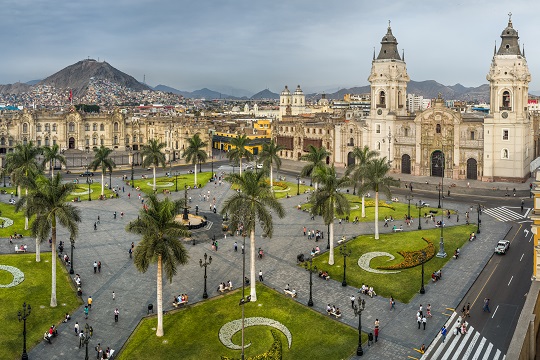With global trade heating up, there are a number of export opportunities worth exploring for Canadian companies. In this article, we highlight Germany, Peru and Vietnam and examine the economic environment, trade relationship, export potential and market challenges of doing business with these countries.
Export Development Canada’s (EDC) Country Risk Quarterly
This interactive tool can help you understand your export and foreign investment risks in 50 markets. Free registration gives you fast access to a wide range of information and resources.
Germany
“Germany has one of the world’s most advanced economies and is a global economic powerhouse,” says EDC’s Klaus Houben, senior regional manager for Europe. “Thanks to the country’s intensive research and innovation, together with its ability to attract large amounts of FDI (foreign direct investment), it boasts the largest economy in Europe and the fourth-largest worldwide.”
The German economy expanded steadily after the end of the 2009 economic crisis, and despite its growth faltering during with the onset of the global pandemic, Germany’s 5% contraction in gross domestic product (GDP) in 2020 was one of the smallest in Europe. Robust economic growth is expected to resume in 2021 and beyond.
The Comprehensive and Economic Trade Agreement between Canada and the European Union (CETA) already gives Canadian companies relatively easy access to the EU market directly from Canada. Establishing a business presence in Germany can provide a Canadian firm with a range of other advantages:
- Germany is strategically located in the centre of Europe, with excellent logistics capabilities that provide rapid access to all European markets and suppliers.
- It’s the largest consumer market in Europe, measured in both population size and purchasing power.
- Germany offers powerful R&D and investment incentive packages that can help reimburse a project’s costs to the investor. It’s also a reliable investment environment with strong protections for intellectual property.
- The country is a world leader in high-technology R&D and offers an ideal environment for innovation. Close co-operation between industry and major research institutions helps transform new ideas into products for the world market.
- Germany’s reputation for productivity, quality and innovation is founded largely on the country’s highly skilled workforce, which boasts exceptional levels of educational attainment.

Opportunities
Germany is Canada’s largest EU export market and our sixth-largest trading partner globally. In 2020, our Germany-bound exports were worth $6.37 billion, while we bought $17.27 billion in German goods. Key export sectors for Canada include aerospace, advanced manufacturing, automotive products, life sciences, information and communications technologies, and agri-food.
The German market is also open to entrepreneurial investment in practically all areas, with good opportunities in several sectors:
- Germany is reinventing its auto industry from the ground up, especially in the areas of electric and hybrid drivetrains, autonomous driving, emission controls and smart technologies related to the sector.
- The German health-care market can be attractive, especially for investment in hospitals, nursing homes, rehabilitation facilities and medical-care centres. Nursing care, outpatient care, dentistry and ophthalmology can also offer good returns for investors.
- Germany intends to meet at least 80% of its energy needs through renewable sources by 2050. Investments in solar, wind, biomass, hydroelectricity, battery storage and other renewable technologies such as green hydrogen can be attractive.
- Technologies such as electronics, robotics and advanced software are being combined to support manufacturers’ efforts to save energy and resources.
- Digital technology is fostering the development of high-speed networks, open architectures and intelligent infrastructures that communicate with each other.
Challenges
Apart from the barriers associated with EU regulations, Germany presents few obstacles to Canadian trade or investment. That said, zealous application of safety and environmental standards, as well as high labour costs, can complicate access to the market. For some companies, the language barrier may also be an issue.
If you want to set up a German affiliate, expect to spend several months doing so. All new businesses must register with:
- the appropriate local chamber of industry and commerce;
- local office of business and standards;
- local commercial register; and
- relevant professional trade associations before they can operate.
There’s also a capital requirement of $37,400 or 25,000 euros for a GmbH (Ltd.). In addition, the German tax and fiscal systems are extremely complex, so you should always work with financial professionals when operating in Germany. On the other hand, German tax rates on corporate profits aren’t particularly high.
Germany also has a shortage of skilled labour. This could cause staffing problems if you decide to establish a German affiliate, and it could also affect your growth targets. Many German companies offer in-house training programs for their employees and, depending on your sector, you may need to do the same to attract scarce workers.
Market entry
According to Klaus Houben, “The German market prefers innovative, high-quality products with up-to-date styling and competitive prices, together with local after-sales support. Consumer interests and tastes, however, vary from one German region to another, so your overall market strategy should allow for these differences. Since most of your competitors will be established German firms with a strong market presence, you can expect stiff competition. Consequently, using experienced representatives will be vital to your market strategy both on market entry and in the longer term.”
For help with entering the German market, consult the Canadian Trade Commissioner Services teams in the country, as well as resources such as the Canadian German Chamber of Industry and Commerce.
- Short-term risk rating: Low
- Top Canadian exports (2020): Precious metals, minerals, machinery, chemicals, agri-food, optical and other instruments, vehicles and aircraft
- Canadian exports total value (2020): $5.5 billion
- International trade agreements with Canada: CETA
- Population: 84.1 million
Peru

Peru has been one of Latin America’s fastest-growing economies since 2002. Economic reforms and cautious fiscal policies have produced swift growth, low inflation and falling poverty rates.
“Peru is an investment-grade country,” says Rafael Castillo, Export Development Canada’s regional manager for Peru. “It’s noted for its good business climate, a clear regulatory framework for investment, and agreements that guarantee stable regimes for investors. On the overall ease of doing business, it stands fourth in Latin America’s regional rankings. Canada also has a long commercial history in Peru, especially in the mining, infrastructure and financial sectors.”
With its membership in various trade blocs, including the Pacific Alliance and the Asia-Pacific Economic Cooperation group (APEC), Peru is well-integrated into the global economy. Canada has had a free trade agreement with the country since 2008, and we’re both members of the Comprehensive and Progressive Agreement for Trans-Pacific Partnership (CPTPP).
However, investors are monitoring closely the current political environment, especially in regards to reforms related to constitutional changes and mining tax regulations coming from the new administration. While it’s too early to make conclusions, investors will remain cautious and some volatility can be expected.
You should also check out
Maximize your company’s success in Brazil, Chile, Colombia, Mexico and Peru
Opportunities
According to EDC economist, Daniel Benatuil with the Economic and Political Intelligence Centre, Peru offers export and investment opportunities across a range of sectors. “These include mining, infrastructure, renewable energy, agriculture and technology and financial technology. Sustainable development is increasingly a focus, including climate-related investing.”
Castillo notes that mining is one of the key Peruvian industrial sectors, and for good reason. “Peru is Latin America’s largest producer of gold and lead, and the world’s second-largest source of copper, silver and zinc. Reflecting this is the size of the mining pipeline, which is composed of 46 projects worth US$56 billion. On the infrastructure and energy side, the government has established a 2021–2022 pipeline with 20 projects across various sectors, worth more than US$6 billion in all.”
Challenges
As with any international market, doing business in Peru has challenges. Given the environmental, political and social issues within the country, companies must ensure that their projects meet the highest standards of corporate social responsibility and sustainable investing. This will help maintain good community relations and reduce the likelihood of company versus community disputes.
Another difficult area can be regulations and their associated bureaucratic hurdles. These have been increasing over the years, which can delay the paperwork and permits needed for a project. There are also potential reputational and corruption risks, so careful due diligence is necessary before you meet prospective business partners or enter into agreements with them.
The political situation is also somewhat unpredictable. “A new administration took office in July 2021,” says Benatuil. “The elections and first weeks of the new administration have been highly polarizing, which could tilt the business environment and investment landscape. Public discontent and a push for greater social protection could also have implications for the government’s finances. That said, Peru has a track record of separating politics from economics, so there may be very little change in business stability. However, that doesn’t take away from the uncertainty making appropriate risk management and due diligence important in taking advantage of the tremendous opportunities.”
Finally, there’s the ubiquitous presence of the pandemic. “Peru is experiencing high rates of infection and deaths relative to its population and the vaccination progress is slow,” says Benatuil. “The country’s high unemployment will also be a drag on overall growth, but Peru’s strong fiscal profile, high commodity prices and large financial buffers will help protect it. And the current downturn is temporary, so there’s every likelihood that Peru’s eventual economic recovery will be strong if supported by political stability.”
Castillo offers three key tips for Canadian companies looking to do business in Peru.
- Use the Canadian Trade Commissioner Service (TCS) to help assess market potential, identify qualified contacts, solve problems and connect you with local professionals.
- Use EDC’s financing and insurance services, as well as our market knowledge and network, to help you develop a presence in Peru.
- Having a local presence is crucial, so you should consider using joint ventures, licensing agreements with partners, or agents and distributors.
- Short-term risk rating: Medium-high
- Top Canadian exports (2020): Agricultural products, machinery, paper products, fertilizers, mineral fuels and oils, metals and minerals
- Canadian exports total value (2020): $851 million
- International trade agreements with Canada: CPTPP; Canada-Peru Free Trade Agreement; Canada-Peru Foreign Investment Promotion and Protection Agreement
- Population: 33.4 million

Vietnam
Even before COVID-19 erupted across the globe, Vietnam had one of the fastest-growing economies in the Asia-Pacific. It’s projected to expand at an annual rate of 6% to 8% annually over the medium to long term as the country, and its supply chains, adapt to the effects of the pandemic.
Foreign direct investment (FDI) and export manufacturing have been major contributors to Vietnam’s growth. Both of these have increased in part because of the United States-China trade tensions, which have caused some multinationals to expand their existing Vietnamese manufacturing facilities or establish new ones. European and American firms are also interested in Vietnam as they look to diversify their supply chains and make them more resilient. The World Bank’s Ease of Doing Business ranking now places Vietnam as 68 out of 190 countries, a respectable boost from its 99th place in 2010, which points to its improvements in the local business environment.
Opportunities
Vietnam is one of Canada’s top export destinations in the Association of Southeast Asian Nations (ASEAN) region. In 2020, we shipped $713 million worth of goods to the country, despite the effects of the pandemic. Agri-food accounted for about $370 million of this, but forest products, plastics, chemicals, metals and machinery were also significant. In return, we purchased a little more than $8 billion in Vietnamese goods.
According to Ian Tobman, EDC Economics senior analyst, “Minimum wages are rising in Vietnam, so it’s less important as a low-skill labour pool than it used to be. But for a Canadian company seeking to diversify its international business, Vietnam’s manufacturing capabilities may be very attractive, especially as it is quickly shifting to higher-value industrial activities. The country’s sizeable population of 100 million people provides a growing consumer base that’s equivalent to 20% of the population of the European Union. Finally, Vietnam is logistically well-positioned to sell into both the Chinese market and other Southeast Asian economies.”
But it’s not only its robust growth that makes Vietnam an attractive opportunity market for Canadian exporters. Both nations are members of the Comprehensive and Progressive Agreement for Trans-Pacific Partnership (CPTPP), which will:
- Reduce the current high Vietnamese tariffs on many categories of Canadian exports, including agri-food, lumber, chemicals and metals, over the next three to 10 years.
- Liberalize the rules for government procurement, investment, financial services, intellectual property rights and digital trade, which will make doing business in Vietnam easier and more attractive for Canadian companies.
- Establish a rules of origin classification system that may help Canadian, Vietnamese and other CPTPP-member exporters integrate their supply chains. This could allow them to benefit from rules of origin tariff exemptions on their goods when they export them to other CPTPP countries.
In addition, Vietnam is a member of the Regional Comprehensive Economic Partnership (RCEP), a 15-nation free trade agreement that includes China and covers about 30% of global gross domestic product (GDP). “While Canada isn’t a RCEP member, the agreement could have indirect benefits for Canadian companies,” says Joy Rankothge, EDC’s chief representative for Southeast Asia.
“When certain conditions are met, a Vietnamese affiliate of a Canadian business would enjoy the same free access to the other RCEP and ASEAN markets as a local firm—including China, with whom Canada has no free trade agreement.”
Challenges
The public sector represents about one-third of the overall economy, as reflected in the dominance of state-owned enterprises (SOEs). These enterprises receive various benefits not shared by other businesses in the economy such as better access to land and advantages in local court disputes. Equitization, the term used in Vietnam to privatize the SOEs, has had a mixed track record, and at present, the government’s liberalization drive seems to have stalled. Access to credit for domestic firms is also a persistent problem.
Another challenge is navigating the country’s bureaucracy, which remains cumbersome despite some incremental liberalization. Managing corruption risk is another issue, as private-sector surveys regularly mention demands for “facilitation payments” from some officials.
Market entry
“Because of these challenges, Vietnamese partners and agents with local knowledge will be vital to your success, especially as you enter the market,” says Rankothge. “But you should always carry out deep due diligence into their reputations, performance and finances before undertaking any agreements with them. To do this, use the Trade Commissioners Service teams in the country, as well as resources such as the Canadian Chamber of Commerce Vietnam. Finally, be sure to use professional service firms to obtain reliable legal and tax advice.”
- Short-term risk rating: Medium-high
- Top Canadian exports (2020): Agri-food, forest products, plastics, chemicals, metals and machinery
- Canadian exports total value (2020): $713 million
- International trade agreements with Canada: CPTPP
- Population: 98.3 million







